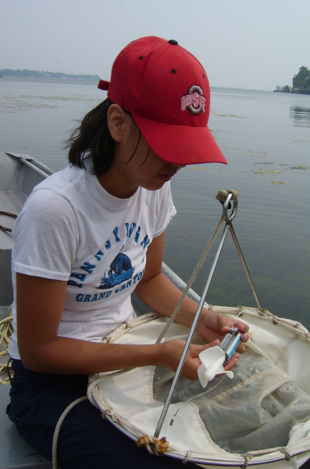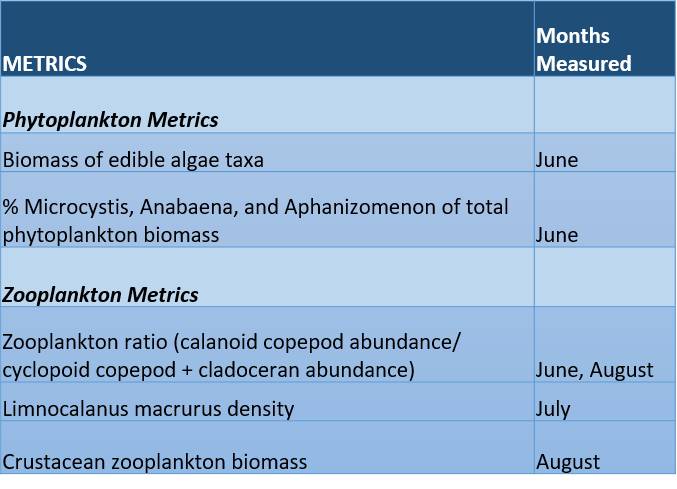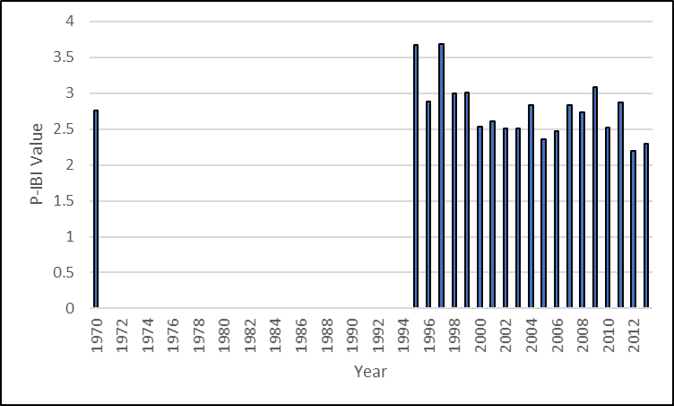Detroit River-Western Lake Erie Basin Indicator Project
Plankton Communities in Western Lake Erie
Authors
Douglas D. Kane, Defiance College, Defiance, Ohio, USABackground
Plankton are small plants or animals that float, drift, or weakly swim in the water column of any water body. Studies of zooplankton and phytoplankton communities of the western basin of Lake Erie extend back to the late-19th/early-20th century (Herdendorf, 2005). Later, research associated with the 1970 “Project Hypo” study of the central basin provided important information on the spatial and temporal dynamics of both phytoplankton (Munawar and Munawar, 1976) and zooplankton (Watson, 1976) for the western basin as well. Further, data collected and analyzed from this period provide us with information regarding the western basin of Lake Erie at its most degraded state (Kane et al., 2005). Degradation of the plankton communities was already evident by the mid-20th century (Beeton, 1965), with evidence for increases in abundance of phytoplankton (Davis 1964) and zooplankton (Bradshaw, 1964) associated with eutrophic conditions, and decreases in abundance of pollution intolerant zooplankton taxa (i.e. Limnocalanus macrurus) (Kane et al., 2004). Since the late 1970s the U.S. Environmental Protection Agency has monitored the phytoplankton and zooplankton communities of western Lake Erie (Makarewicz, 1993a,b). The data available from the different studies mentioned above, combined with more recent data collected, allow for the determination of the biological integrity of the offshore waters of the western basin of Lake Erie.
One measure of the biological integrity of the offshore waters of the western basin of Lake Erie is the Planktonic Index of Biotic Integrity (P-IBI) (Kane et al., 2005). This indicator is based on the abundance and kinds of phytoplankton and zooplankton. The P-IBI integrates information about both phytoplankton and zooplankton communities in the open waters of western Lake Erie to determine their water quality (Figure 1).

Figure 1. Researcher taking a zooplankton sample in the western basin of Lake Erie near the Bass Islands. (photo credit: Doug Kane).
Status and Trends
The Planktonic Index of Biotic Integrity (P-IBI) uses five characteristics (metrics; Table 1). Values obtained for these plankton metrics are classified to reflect different levels of pollution by nutrients, especially phosphorus. Each metric is scored as a one, three, or five, with five representing the most oligotrophic conditions. Because both phytoplankton and zooplankton communities change throughout the year (Sommer et al.,1986), each metric has a specific time component during which it is measured (June-August; Table 1). The metric scores for all the months are then averaged.
Table 1. Metrics used to calculate the Plankton Index of Biotic Integrity (P-IBI).


The P-IBI suggests the overall condition of the western basin of Lake Erie’s offshore waters for the most recent years is eutrophic (Figure 2; Kane et al., 2015). During the mid-to-late 1990s the P-IBI scores were higher, reflecting a more mesotrophic western basin (Figure 2). Since 2000 the P-IBI scores have been at or below 3, similar to the score for 1970 (Figure 2), reflecting eutrophic conditions. These scores reflect increased frequency of blooms of the toxic phytoplankter Microcystis (Budd et al., 2002), increases in phytoplankton community biomass (Conroy et al., 2005b), and declines in the zooplankton ratio (Conroy et al., 2005a). The P-IBI values have continued to decline in recent years (Kane et al., 2015). This decline is in large part because of cyanobacteria Harmful Algal Blooms (cHABs) that are larger in geographic extent, more frequent, and longer in duration and are plaguing the western basin of Lake Erie nearly every year.

Figure 2. P-IBI scores in the western basin of Lake Erie, 1970 and 1995-2013. Trophic status classifications are based on IBI scores and are based on the scale of less than 3 reflecting eutrophic conditions, 3-4 reflecting mesotrophic conditions, and greater than 4 reflecting oligotrophic conditions.
Management Next Steps
A number of different agencies and academic researchers collect plankton samples in the western basin of Lake Erie. However, there is no coordinated effort to maximize spatial and temporal coverage, standardize methods among research/management groups, or share the results among all interested parties. A binational “plankton monitoring summit” would be helpful for all the parties involved, as coordinated monitoring effort would have greater spatial and temporal coverage, greater comparability of data, and likely be more cost efficient.
A reduction in nutrient loading is a management goal for reducing c-HABs and improving overall ecosystem health in the western basin of Lake Erie. A return to mesotrophic conditions is a best-case scenario for the western basin considering the shallowness of the basin and its high influence from large rivers flowing into the basin from agricultural and urban areas. The P-IBI mesotrophic range of 3-4 is a reasonable target to be considered by management agencies.
Research/Monitoring Needs
Phytoplankton and zooplankton are good indicators of changes in nutrient pollution over time in Lake Erie, because they respond quickly to changes in nutrient input to the lake. Further, they can be sampled extensively in many locations with relative ease. Future monitoring of plankton dynamics in Lake Erie will enable us to evaluate the biological water quality of Lake Erie’s offshore waters. The Ohio Department of Natural Resources in Ohio, the National Water Research Institute in Canada and other state, provincial, and federal agencies have shown a long-term commitment to plankton monitoring, which has allowed for the calculation of P-IBI scores for nearly 18 years of data. This monitoring has also allowed for the early detection of invasive species new to the western basin of Lake Erie (i.e., Cercopagis pengoi) (Therriault et al. 2002) and needs to continue in the future in order to detect changes in the lake.
References
- Beeton, A.M. 1965. Eutrophication of the St. Lawrence Great Lakes. Limnol. Oceanogr. 10: 240-254.
- Bradshaw, J.S. 1964. The crustacean zooplankton picture: Lake Erie 1939-49-59, Cayuga 1910-51-61. Verh. Int. Ver. Theor. Angew. Limnol. 15: 700-708.
- Budd, J.W., Beeton, A.M., Stumpf, R.P., Culver, D.A., and Kerfoot, W.C. 2002. Satellite observations of Microcystis blooms in western Lake Erie. Verh. Int. Ver. Theor. Angew. Limnol. 27: 3787-3793.
- Conroy, J.D., D.D. Kane, and D.A. Culver. 2005a. Declining Lake Erie ecosystem health? Evidence from a multi-year, lake-wide, plankton study. In: M. Munawar and R. Heath (eds.), Checking the Pulse of Lake Erie. Edited by M. Munawar, and R.T. Heath. Ecovision World Monograph Series Aquatic Ecosystem Health and Management Society. Burlington, Ontario, Canada.
- Conroy, J.D., D.D. Kane, D.M. Dolan, W.J. Edwards, M.N. Charlton, and D.A. Culver. 2005b. Temporal trends in Lake Erie plankton biomass: roles of external phosphorus loading and dreissenid mussels. J. Gt. Lakes Res. 31 (Supplement 2): 89-110.
- Davis, C.C. 1964. Evidence for the eutrophication of Lake Erie from phytoplankton records. Limnol. Oceanogr. 9: 275-283.
- Herdendorf, C.E. 2005. Scientific surveys of Lake Erie: a historical review. Ohio Sea Grant Technical Bulletin (TB-077). Columbus, Ohio, USA.
- Kane, D. D., Gannon, J.E., and Culver, D.A. 2004. The Status of Limnocalanus macrurus (Copepoda: Calanoida: Centropagidae) in Lake Erie. J. Great Lakes Res. 30: 22-30.
- Kane, D.D., S.I. Gordon, M. Munawar, M.N. Charlton, and D.A. Culver. 2005. A Planktonic Index of Biotic Integrity (P-IBI) for Lake Erie: a new technique for checking the pulse of Lake Erie. In Checking the Pulse of Lake Erie. Edited by M. Munawar, and R.T. Heath. Ecovision World Monograph Series Aquatic Ecosystem Health and Management Society. Burlington, Ontario, Canada.
- Kane, D.D., S.A. Ludsin, R.D. Briland, D.A. Culver, and M. Munawar. 2015. Ten+ years gone: Continued degradation of offshore planktonic communities in U.S. waters of Lake Erie’s western and central basins (2003-2013). J. Great Lakes Res. 41:930-933.
- Makarewicz, J.C. 1993a. A lakewide comparison of zooplankton biomass and its species composition in Lake Erie, 1983-87. J. Great Lakes Res. 19:2 75-290.
- Makarewicz, J.C. 1993b. Phytoplankton biomass and species composition in Lake Erie, 1970 to 1987. J. Great Lakes Res. 19: 258-274.
- Munawar, M., and I.F. Munawar. 1976. A lakewide study of phytoplankton biomass and its species composition in Lake Erie, April- December 1970. J. Fish. Res. Board Can. 33: 581-600.
- Sommer, U., Z.M. Gliwicz, W. Lampert, and A. Duncan. 1986. The PEG-model of seasonal succession of planktonic events in fresh waters. Arch. Hydrobiol 106: 433-471.
- Therriault, T.W., I.A. Grigorovich, D.D. Kane, E.M. Haas, D.A. Culver, and H.J. MacIsaac. 2002. Range expansion of the exotic zooplankter Cercopagis pengoi (Ostroumov) into western Lake Erie and Muskegon Lake. J. Great Lakes Res. 28: 698-701.
- Watson, N.H.F. 1976. Seasonal distribution and abundance of crustacean zooplankton in Lake Erie, 1970. J. Fish. Res. Board Can. 33: 612-621.